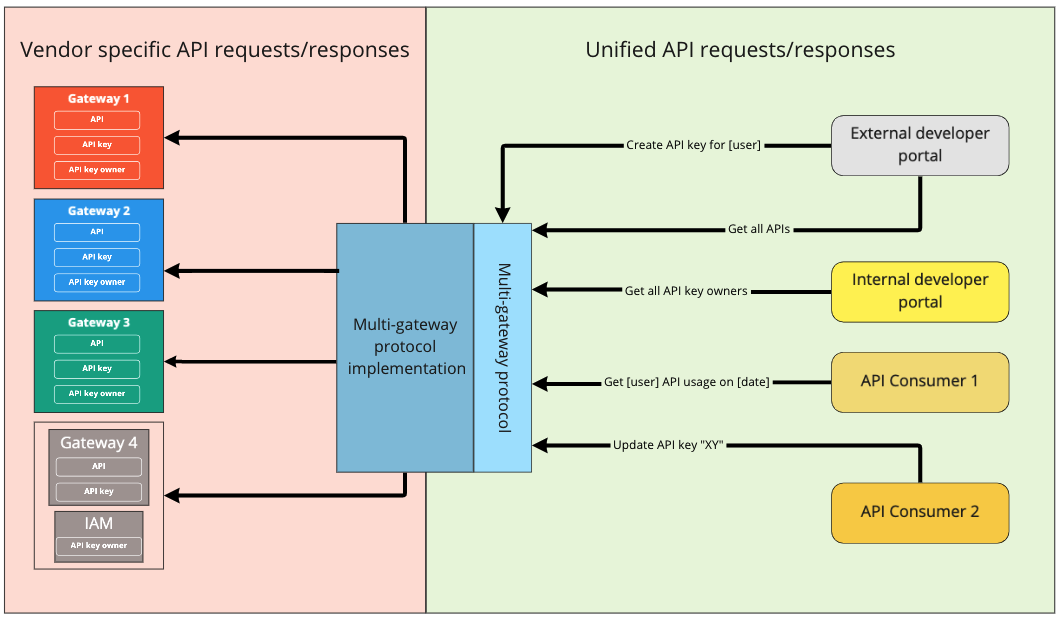One developer portal for multiple API gateways
Breadcrumb
- Home
- PronovixBlog
- One developer portal for multiple API gateways
Multi-gateway developer portals are something that a growing number of our customers and prospects have started asking us about. In most cases the goal is to have a single platform portal that allows organizations to get observability across their API landscape. To achieve this goal, APIs need to be findable and discoverable, and not isolated on a vendor island. This is essential to improve developer experience, and a first step towards a coherent development platform.
Multi-gateway portals make it possible to organize information in a way that makes it easier for developers to form a mental model of an organization’s IT architecture and is related to the need for developer portals to document many different interface types.
Fast key provisioning is an important aspect of developer experience, that is why most gateway providers have an automated provisioning capability in their integrated developer portal solution. The reality is that a lot of businesses can’t provide a frictionless approval process for key provisioning—there is a need to wait for a human to approve the API access request. In the case of an external developer portal, the rules can be very strict. To date, most of our customers have security, data governance, or business reasons why a majority of their APIs require some sort of evaluation step before a developer will get access to an API. Often these approval processes also depend on who is requesting access: the same request might be automatically granted for an internal colleague, and require processing for an external partner.
On the other hand, on external developer portals, mock APIs are often freely available with a free and frictionless onboarding process because this allows you to:
But mock APIs can be hosted on a dedicated infrastructure that is integrated with your developer portal solution, so in this case you might not need a multi-gateway integration.
Another solution is to put a gateway in front of all the other gateways, this allows you to use the full range of features of a gateway like Apigee (for example, for monetisation). In a lot of cases customers express concerns about latency as a result of an extra proxy hop. There are ways to mitigate the latency. For example, moving the gateway proxy closer to the service such as when using a hybrid cloud approach.
Proxying your legacy gateway infrastructure might make sense when:
If the above scenarios don’t work, you will probably need a developer portal that can connect to multiple gateways.
Even in organizations that have done a centrally coordinated API roll-out with a single API gateway there are often parts of the organization that have implemented part of their landscape on top of a second, third or even fourth API gateway. Especially in larger organizations, the convergence of gateway vendors and cloud providers means that they need to deal with a fragmented gateway landscape.
There are also strategic reasons why organizations may deliberately implement APIs across multiple gateways:
In 2020, we drafted a gateway agnostic protocol definition for a customer that wanted to be able to switch gateways without having to reimplement their devportal. The protocol we worked with provided a generalization of the core capabilities that an API management solution usually delivers. Based on the protocol a middleware could be implemented on the customer’s infrastructure and can sit between their gateway and the developer portal we created for them.

A new generation of API management solutions has emerged on the heels of the acquisition wave that brought the largest players in the API management landscape into the hands of the leading cloud vendors. As a result there is now an even larger landscape of API management solutions that all have implemented their own developer portal solution.
Traditionally developer portals have been a part of the evaluation criteria that analysts like Gartner and Forrester use to help organizations choose their gateway solution. But in a world where companies need multi-gateway developer portals, challenger and incumbent gateways might start to bundle their efforts to create a best of class open source developer portal, and to focus on differentiating features in the gateway.
Any gateway that works with a developer portal solution that doesn’t require a customer to migrate APIs, will be more valuable for companies with a mature API program. The key feature of such a generic developer portal solution would be the ability to connect to a broad range of the most important API gateways.
As gateway solutions continue to differentiate, and APIs grow in importance, the growing complexity of the gateway landscape could benefit from an open source gateway protocol and/or bridge that creates an interoperability layer for the community. Such a layer would free up the energy that today flows into point-to-point integration because:
This is the first step towards an integrated coherent capability platform.
We are researching what would be the best solution for the community. If you are interested in an open source gateway connector project, as a user or collaborator, you can help us organize a better project by filling out our questionnaire.
All Pronovix publications are the fruit of a team effort, enabled by the research and collective knowledge of the entire Pronovix team. Our ideas and experiences are greatly shaped by our clients and the communities we participate in.

Kristof Van Tomme is an open source strategist and architect. He is the CEO and co-founder of Pronovix. He’s got a degree in bioengineering and is a regular speaker at conferences in the API, developer relations, and technical writing communities. He is the host of the Developer Success & the Business of APIs and the API Resilience podcasts.
Articles on devportals, DX and API docs, event recaps, webinars, and more. Sign up to be up to date with the latest trends and best practices.

